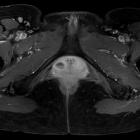Bartholinsche Drüsen

The Bartholin glands, also known as the greater vestibular glands (or vulvovaginal glands) are paired pea-sized structures, lying on either side of the vaginal opening, and are homologous to the bulbourethral (Cowper) glands in the male. They form part of the vulva.
Gross anatomy
These glands are described as less than 1 cm in diameter and found behind the posterior ends of each vestibular bulb. Each gland opens into the posterolateral vaginal orifice (between the hymen and the respective labium minus) via a 2 cm long duct.
The secretory cells within the duct are columnar and secrete lubricating fluid especially during sexual arousal.
History and etymology
The Bartholin glands are named after the Danish anatomist Caspar Bartholin the Younger (1655-1738), who made the first detailed study of their physiology and anatomy in human females. Earlier he jointly discovered the glands in cows with Joseph Guichard du Verney (1648-1730) a French anatomist .
Related pathology
- Bartholin cyst
- Bartholin abscess
- tumors of Bartholin gland
- squamous cell carcinoma
- adenocarcinoma
- adenoid cystic carcinoma
- Bartholinitis
Siehe auch:

 Assoziationen und Differentialdiagnosen zu Bartholinsche Drüsen:
Assoziationen und Differentialdiagnosen zu Bartholinsche Drüsen:

